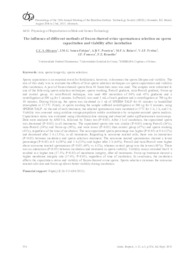The influence of different methods of frozen-thawed ovine spermatozoa selection on sperm capacitation and viability after incubation.
The influence of different methods of frozen-thawed ovine spermatozoa selection on sperm capacitation and viability after incubation.
Author(s): OLIVARES, C. C. S.; SOUZA-FABJAN, J. M. G.; PENEIRAS, A. B. V.; BALARO, M. F. A.; FREITAS, V. J. F.; FONSECA, J. F. da; BRANDÃO, F. Z.
Summary: Abstract: Sperm capacitation is an essential event for fertilization; however, it decreases the sperm lifespan and viability. The aim of this study was to evaluate the effects of four sperm selection techniques on sperm capacitation and viability after incubation. A pool of frozen-thawed sperm from 10 Santa Inês rams was used. The samples were submitted to one of the following sperm selection techniques: sperm washing, Percoll gradient, mini-Percoll gradient, Swim-up and control group. At mini-Percoll technique, was used 400 microliters of 90% and 45% gradients and a centrifugation at 500 xg for 5 minutes. In Percoll, was used 1 mL of each gradient and a centrifugation at 700 xg for 10 minutos. During Swim-up, the sperm was incubated in 1 ml of SPERM-TALP for 45 minutos in humidified atmosphere at 37.5oC. Finaly, at sperm washing the sample suffered centrifugation at 300 xg for 8 minutes, using SPERM-TALP. At the end of each treatment, the selected spermatozoa were incubated at 37oC for 1 h, 2 h, and 3 h. Viability was assessed using acridine orange-propidium iodide combination by computer-assisted sperm analysis. Capacitation status was evaluated using chlortetracycline staining and observed under epifluorescence microscopy. Data were analyzed by ANOVA, followed by Tukey test (P<0.05). After 3 h of incubation, the capacitated sperm was decreased (P<0.05) in all treatments. The capacitated sperm rate was similar (P>0.05) among Percoll (36%), mini-Percoll (34%) and Swim-up (30%), and were lower (P<0.05) than control group (47%) and sperm washing (41%), regardless of the time of incubation. The non-capacitated sperm percentage was higher (P<0.05) at 0 h (12%) and decreased after 3 h (1.5%), in all treatments. Regarding to acrosome reacted cells, there was an interaction (P<0.05) between incubation and sperm selection treatment. The acrosome reacted spermatozoa showed a lower percentage (P<0.05) at 0 h (50%) and 1 h (53%) and higher after 3 h (64%). Percoll and mini-Percoll were higher about acrosome reacted spermatozoa (P<0.05; 60% vs. 61%), whereas control group was the lowest (49%). There was an interaction (P<0.05) between incubation and treatment in sperm viability. Viability assays revealed that 0 h resulted in a higher rate (17.5%; P<0.05) of membrane integrity, after all treatments. Swim-up treatment showed a higher membrane integrity rate (17.4%; P<0.05), regardless of time of incubation. In conclusion, the incubation affects the capacitation status and viability of frozen-thawed ovine sperm. Sperm selection increases the acrosome reacted cells rate and Swim-up allows better viability during incubation. [Influência de diferentes métodos de seleção de espermatozoides ovinos congelados sobre a capacitação e vitalidade espermática após incubação]. Resumo: Apesar de necessária para a fecundação, a capacitação espermática diminui a longevidade e vitalidade dos espermatozoides. Objetivou-se analisar os efeitos de quatro métodos de seleção espermática sobre a capacitação e vitalidade dos espermatozoides após incubação. Foi utilizado pool de sêmen congelado comercial de 10 carneiros da raça Santa Inês. As amostras foram submetidas aos diferentes métodos de seleção: lavagem por centrifugação, gradiente de Percoll, mini-Percoll, Swim-up e grupo controle. Na técnica de mini-Percoll, foi utilizado 400 microlitros dos gradientes de 90% e 45% e a amostra foi submetida a centrifugação por 5 minutos a 5000 xg. Para a técnica de Percoll, foi utilizado 1 mL de cada gradiente e os espermatozoides foram submetidos à força de 700 xg por 10 minutos. Durante o Swim-up, os espermatozoides foram incubados em 1 mL de SPERM-TALP por 45 minutos em atmosfera humidificada a 37,5oC. Já na lavagem por centrifugação, a amostra foi submetida a centrifugação por 8 minutos a 300 x g em SPERM-TALP. Posteriormente, os espermatozoides selecionados foram incubados a 37º C por 1 h, 2 h e 3 h. Foi avaliada a vitalidade por meio de iodedo de propídeo e laranja de acridina pelo sistema de avaliação seminal computadorizada. A capacitação espermática foi analisada pela coloração de hidroclorido de clortetraciclina em microscópio de epifluorescência. O efeito do método sobre os parâmetros foi avaliado pela ANOVA, seguido pelo teste de Tukey (P<0,05). Após 3 h, houve decréscimo da taxa de espermatozoides capacitados (P<0,05) em todos os métodos de seleção. Independente do momento de incubação, a taxa de capacitados foi similar (P>0,05) entre Percoll (36%), mini-Percoll (34%) e Swim-up (30%), as quais foram inferiores (P<0,05) ao grupo controle (47%) e lavagem por centrifugação (41%). A taxa de espermatozoides não capacitados foi superior (P<0,05) no momento 0 h (12%) e diminuiu após 3 h (1,5%), independentemente do método. Houve interação (P<0,05) entre intervalo de incubação e método na taxa de espermatozoides reagidos. O índice de reagidos foi menor (P<0,05) em 0 h (50%) e 1 h (53%) e maior após 3 h (64%). Percoll (60%) e mini-Percoll (61%) apres
Publication year: 2015
Types of publication: Abstract in annals or event proceedings
Unit: Embrapa Goats & Sheep
Observation
Some of Embrapa's publications are published as ePub files. To read them, use or download one of the following free software options to your computer or mobile device. Android: Google Play Books; IOS: iBooks; Windows and Linux: Calibre.
Access other publications
Access the Agricultural Research Database (BDPA) to consult Embrapa's full library collection and records.
Visit Embrapa Bookstore to purchase books and other publications sold by Embrapa.

